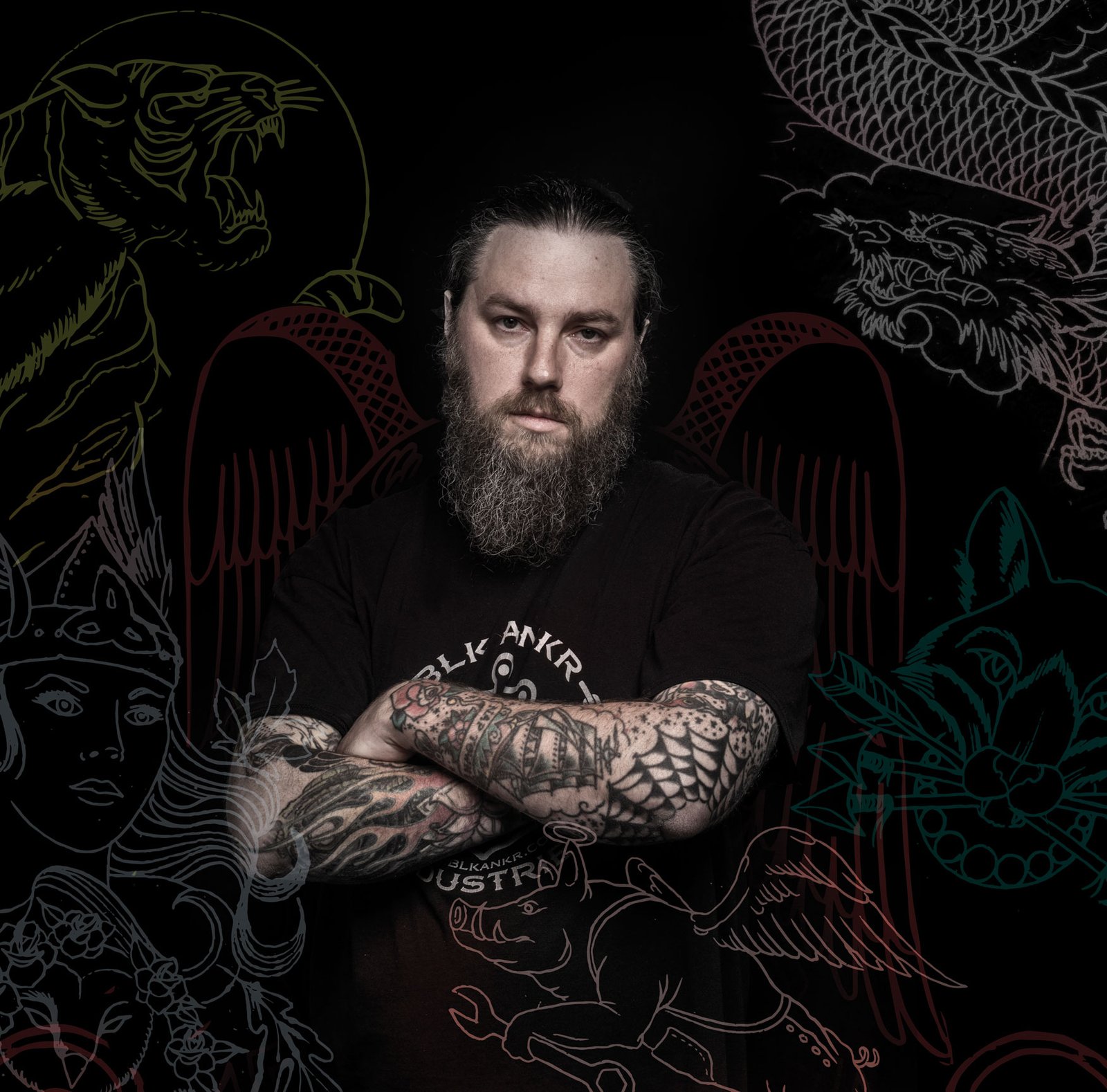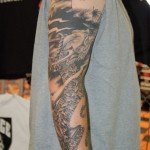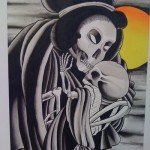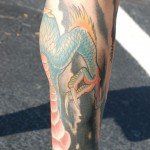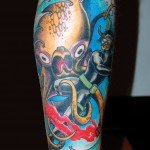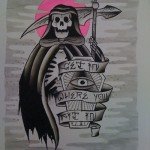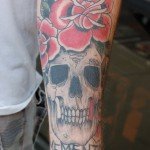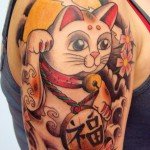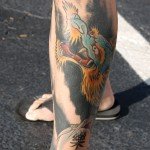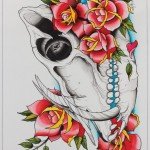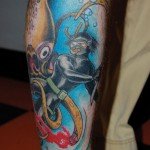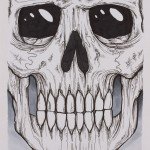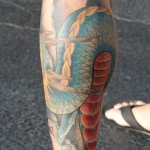+ By Chris Kalman
Above a small, inconspicuous storefront off West Street, between Hudson and Willow, hangs a bold sign that reads Orange in big flowing letters. One could easily miss the other two words, Tattoo Company, in simple small, dark print. When I walk in, the predominant color scheme is—you guessed it—orange. My mind drifts to Tropicana commercials and sunny Florida beaches as I look around the walls, lined with brightly colored skateboard decks. I then cue in on the buzzing of tattoo machines, and am reminded of where I am.
I’m here to talk with Joe “Joweone” Nasatka and am a little nervous. I don’t have any tattoos. I’ve been to a few shops before, with friends who wanted hand-holding or a drop off/pick up. I know what to expect, and I bring those expectations into the interview: tattoo shops can be summed up as dark dungeons of sadomasochists who don’t give a !@# what you think, and you can take your business and shove it if you don’t like their heavy metal music. At least, to date, that had been my experience in tattoo shops. But when I walk through Orange Tattoo Company’s door, most of my preconceptions and misgivings are dispelled. Big south-facing windows keep the room bright, even on a gray day. There is a clerk at the front of the store who greets me when I come in. She is friendly and interested. There’s punk rock music coming from the speakers, but it’s not so loud that I can’t hear myself think. I feel comfortable, which is something I’ve never felt before in a tattoo parlor. Cool.
 In a moment, Nasatka is out front to see me. He’s as much an amalgam of contradictions as the store itself. He’s got a big beard, longish hair, and a strong build. You can tell that he could hold his own in a mosh pit. But he has kind, gentle eyes, and a voice to match. I feel drawn in as he begins telling me how he got into tattoos: “I was born and raised in Annapolis, have an older sister, younger sister. At an early age, I fell in love with skateboarding. Punk rock music took over my life and how I do things. I was definitely the black sheep.” I’m nodding along to the familiar tale. My path in life didn’t take me into punk, but I know what it’s like being the black sheep. Still, Nasatka doesn’t seem to have much of that burning resentment and cynicism that typically accompanies social ostracism.
In a moment, Nasatka is out front to see me. He’s as much an amalgam of contradictions as the store itself. He’s got a big beard, longish hair, and a strong build. You can tell that he could hold his own in a mosh pit. But he has kind, gentle eyes, and a voice to match. I feel drawn in as he begins telling me how he got into tattoos: “I was born and raised in Annapolis, have an older sister, younger sister. At an early age, I fell in love with skateboarding. Punk rock music took over my life and how I do things. I was definitely the black sheep.” I’m nodding along to the familiar tale. My path in life didn’t take me into punk, but I know what it’s like being the black sheep. Still, Nasatka doesn’t seem to have much of that burning resentment and cynicism that typically accompanies social ostracism.
Nasatka’s interest in punk music kindled his interest in tattoos. He started paying attention to the album art and tattoos of his favorite musicians. “Pushead, Coop, Kozik—those guys really turned me on to art.” In 1994, right out of high school, he accepted a job at Capitol Tattoo in Silver Spring. Already an artist at the time, his focus was mostly on painting and drawing. His co-worker James Hughes saw Nasatka’s potential and began to take him under his wing as an apprentice. In the beginning Nasatka mostly practiced on friends. “[They] were willing to let me make mistakes,” he chuckles, “under the promise, of course, that ‘you’d fix it up when you got better at it.’” But it wasn’t all fun and tattoos. The apprenticeship included a lot of hard and dirty work. Whether scrubbing toilets, answering phones, or doing any number of other odd jobs, he paid his dues for a year or more before he really got his start.
 Back then, there were fewer “tear-jerker” tattoos, as Nasatka describes them. People just wanted to get ink, and many didn’t care what particular ink that would be. He recounts one of his first big tattoos. The shop had a running contest of sorts to see whether someone would get a tasteless tattoo if the price was right. On a chalkboard in front, someone would draw something—“As bad a drawing as you could make,” says Nasatka—“and give it a special low price.” There was once an outlandish drawing of a cat’s head up there, and one day somebody came in and asked for the cat’s head. “My boss looked at me, and I knew I was up. I just played along and pretended like I’d been doing this forever,” he tells me, laughing.
Back then, there were fewer “tear-jerker” tattoos, as Nasatka describes them. People just wanted to get ink, and many didn’t care what particular ink that would be. He recounts one of his first big tattoos. The shop had a running contest of sorts to see whether someone would get a tasteless tattoo if the price was right. On a chalkboard in front, someone would draw something—“As bad a drawing as you could make,” says Nasatka—“and give it a special low price.” There was once an outlandish drawing of a cat’s head up there, and one day somebody came in and asked for the cat’s head. “My boss looked at me, and I knew I was up. I just played along and pretended like I’d been doing this forever,” he tells me, laughing.
The tattoo industry has changed a lot since then. Today, people tend to want tattoos that mean something to them and are very specific about what they want. “Sometimes their ideas are feasible, sometimes they aren’t,” he says. Either way, the consultation process is much longer and more in-depth than it used to be. He doesn’t mind this, though, even if it costs him money. “Some people come in with an idea of what they want, and it’s just really not going to look good in five years,” he explains. “They might get mad at me when I say I won’t do it, but I’m not going to lie to someone and say it will look good if I know it won’t.” Nasatka, like most tattoo artists, gets paid per tattoo, not per hour; if he turns down a client, he loses money. “Some of those people go off and find a tattoo artist who will go ahead and do it anyway. And you know what? Some of them come back to me after five years and say ‘you were right,’ and ask me if I can fix it.” He’s not at all smug as he says this; he’s just being matter-of-fact. Tattooing is an art, and Nasatka knows his medium.
 Orange Tattoo opened its doors in 2010, after the previous tattoo shop in town had tanked, and when a few others were popping up in the area. Nasatka looks around at the unique floor layout and open atmosphere. “Orange started with the concept of creating an open, comfortable, friendly place that was not the status quo, but still remained true to our punk music and skateboarding roots,” he says. “We wanted to create a place where everyone gets treated well, and nobody gets ignored.”
Orange Tattoo opened its doors in 2010, after the previous tattoo shop in town had tanked, and when a few others were popping up in the area. Nasatka looks around at the unique floor layout and open atmosphere. “Orange started with the concept of creating an open, comfortable, friendly place that was not the status quo, but still remained true to our punk music and skateboarding roots,” he says. “We wanted to create a place where everyone gets treated well, and nobody gets ignored.”
While tattooing has become more mainstream and the tear-jerker tattoo predominates, Nasatka has begun focusing more on his other artistic outlets, such as painting, drawing, concert posters, and album art. “I get these ideas that would make really great tattoos,” he tells me. “Or I’ll get a client, and I’ll draw up four designs for a tattoo. Of course, he only takes one of those designs. The other ones I might like better, though. I can expand those into these larger paintings or drawings. So the two mediums really inspire one another.”
As we wrap up the interview, the shop is buzzing. There are three machines working and a couple of customers in the front, looking through tattoo books. For Joe Nasatka and Orange Tattoo, it’s just another busy day at the office. █

